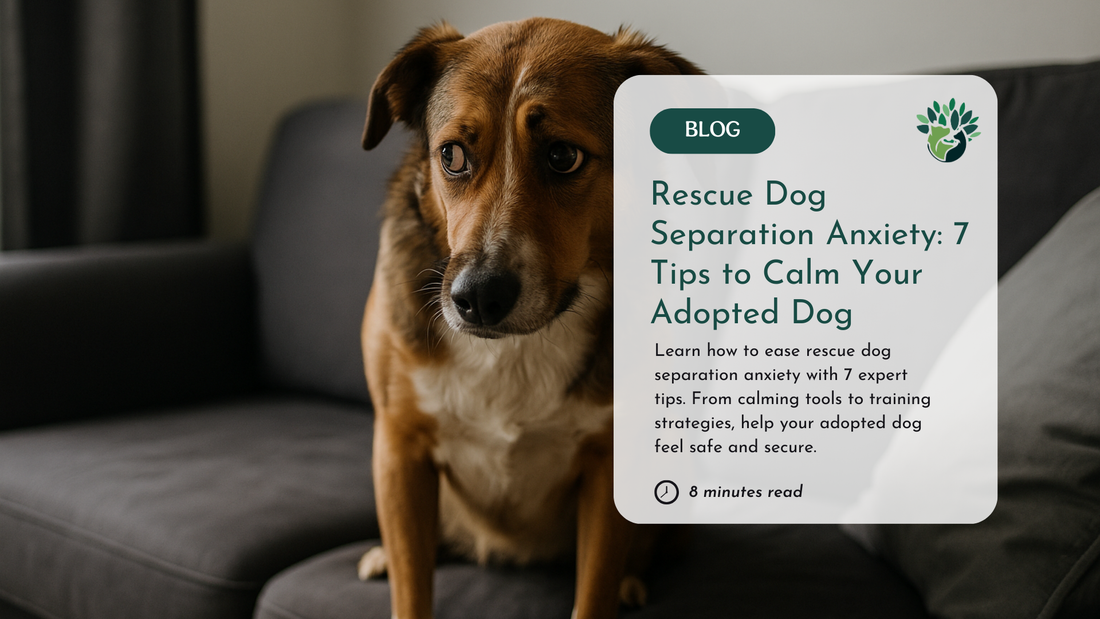Rescue dog separation anxiety is a common challenge for many pet parents. Dogs adopted from shelters or rescued from neglectful situations often carry emotional scars that impact their ability to feel secure—especially when left alone. Their fear of abandonment, trauma, and lack of stable early relationships can lead to anxiety that manifests as destructive behavior, excessive barking, or even physical health concerns.
With patience, consistency, and the right strategies, pet parents can help their rescue dogs feel safe, supported, and confident—even during times of separation. This article offers practical, compassionate tips to support dogs struggling with separation anxiety, especially those adopted through rescue efforts. And with National Rescue Dog Day shining a spotlight on the importance of adoption, there’s no better time to learn how to care for your rescued companion.
Why Rescue Dogs Experience Separation Anxiety
Not every rescue dog develops separation anxiety, but those who do often show signs of distress when left alone. Understanding the root causes can help pet parents take the right steps to support their dog’s emotional well-being.
Previous Trauma
Many rescue dogs have endured abuse, neglect, abandonment, or long stays in overcrowded shelters. These experiences leave lasting emotional scars, often creating a deep fear of being left alone.
Abrupt Environmental Changes
Moving from a shelter or foster home into a new environment can feel overwhelming. Sudden changes in surroundings, routines, and people can trigger anxiety as the dog struggles to understand if this new place is truly safe.
Inconsistent Human Bonding
Dogs thrive on secure, consistent relationships. Rescue dogs who experienced neglect or had multiple owners may feel unsure whether their new bond will last, leading to heightened anxiety when their pet parent leaves.
Unknown Background
Many rescue dogs come with little or no information about their past. Without knowing their specific triggers or traumas, it can be challenging to anticipate and address their stress responses.
Sensitive Temperament
Some dogs are naturally more anxious or sensitive than others. Dogs with shy or fearful personalities may be more prone to separation anxiety, even in a stable environment.
How to Help a Rescue Dog with Separation Anxiety
Fortunately, there are proven strategies to ease separation anxiety and build a rescue dog’s confidence and sense of security.
1. Rule Out Medical Causes
Before assuming a dog’s behavior is emotional, schedule a check-up with a veterinarian. Health issues like bladder infections, digestive problems, or pain can cause symptoms that mimic separation anxiety. Once medical concerns are ruled out, pet parents can focus on emotional and behavioral support.
2. Provide Enrichment and Exercise
Daily mental and physical exercise is essential for managing rescue dog separation anxiety. A tired dog is less likely to experience anxiety-driven behaviors like chewing, barking, or pacing.
-
Take your dog on a long walk or play an active game before leaving the house.
-
Use puzzle feeders or treat-dispensing toys to keep them occupied while you’re gone.
-
Rotate toys regularly to maintain interest.
-
Practice obedience training or scent games to challenge their brain.
Providing this kind of stimulation builds confidence and relieves boredom, which often exacerbates anxiety.
3. Try Calming Tools and Devices
Calming products can help dogs cope with separation anxiety. One of the best option is the Pet PEMF Mat. This mat uses pulsed electromagnetic field (PEMF) therapy to promote relaxation, reduce stress, and support overall emotional balance. It’s non-invasive, drug-free, and simple to use—just let your dog rest on the mat for a session, and the gentle electromagnetic pulses will help calm their nervous system.
4. Use Desensitization Techniques
Gradually teaching your dog that being alone is safe is key to overcoming rescue dog separation anxiety. This technique, known as systematic desensitization, involves:
-
Leaving the dog alone for short periods.
-
Gradually increasing the time apart.
-
Returning calmly and without fanfare.
-
Rewarding calm behavior upon return.
Avoid sudden changes in routine. If weekends are packed with activities together, build short separations into the schedule so the dog doesn’t associate your presence with constant availability.
5. Keep Greetings and Goodbyes Neutral
Overly emotional departures or arrivals can increase a dog’s stress and reinforce the idea that leaving is a big, scary event.
-
Avoid lingering at the door or making a fuss when saying goodbye.
-
Return home with a calm attitude.
-
Wait until the dog is relaxed before engaging in play or affection.
This approach normalizes comings and goings, teaching the dog that their pet parent always comes back.
6. Try Natural Alternatives
If CBD oil isn’t the right fit for your dog, there are other natural remedies to consider:
-
Reishi Mushroom: Known as the "mushroom of immortality," reishi is a powerful adaptogen that supports emotional balance and helps dogs manage stress caused by separation, loud noises, or changes in routine. Its calming properties have been used for centuries to promote relaxation and overall well-being in both humans and animals
-
Bach Flower Remedies: These gentle, plant-based remedies can help ease anxiety and promote a sense of calm. Rescue Remedy is a popular choice for pets.
-
L-Theanine: Found in green tea, this amino acid promotes relaxation without sedation. It’s often used in supplements designed for anxious pets.
For pet parents looking for a comprehensive solution, consider our Serenity & Calm Support – Cognitive and Anxiety Support supplement bundle. This carefully curated package is designed to support pets with anxiety while supporting cognitive health. It’s a holistic approach to creating a calm, happy, and balanced life for your furry companion.
7. Seek Professional Guidance
Severe anxiety often requires professional intervention. A Certified Holistic Pet Health Coach with relevant background and experience can evaluate the dog’s specific needs and design a personalized plan.
For extreme cases—such as self-injury, severe destruction, or escape attempts—professional help is essential. Holistic coaches specialize in natural, supportive techniques that prioritize emotional healing and trust-building.
Rescue Dogs Deserve Support
Helping a rescue dog overcome separation anxiety is one of the most meaningful ways to honor their journey. National Rescue Dog Day, celebrated every May 20th, reminds us of the resilience and love these dogs bring into our lives—and the responsibility we have to support their physical and emotional health.
With compassion, routine, and the right tools, pet parents can help their rescue dogs feel secure and loved. Every rescue dog deserves not only a second chance but also a peaceful, happy life filled with safety and care.
















